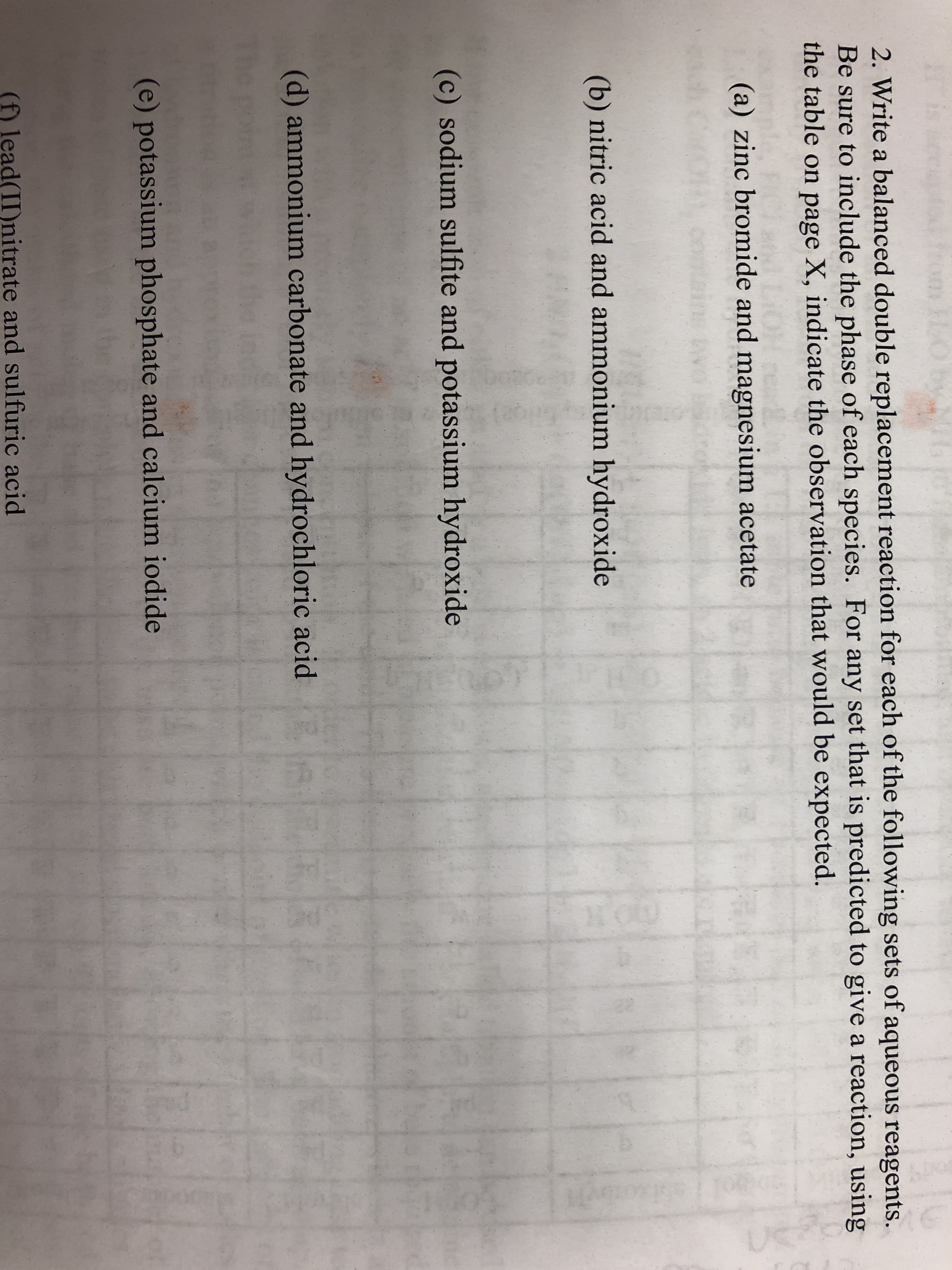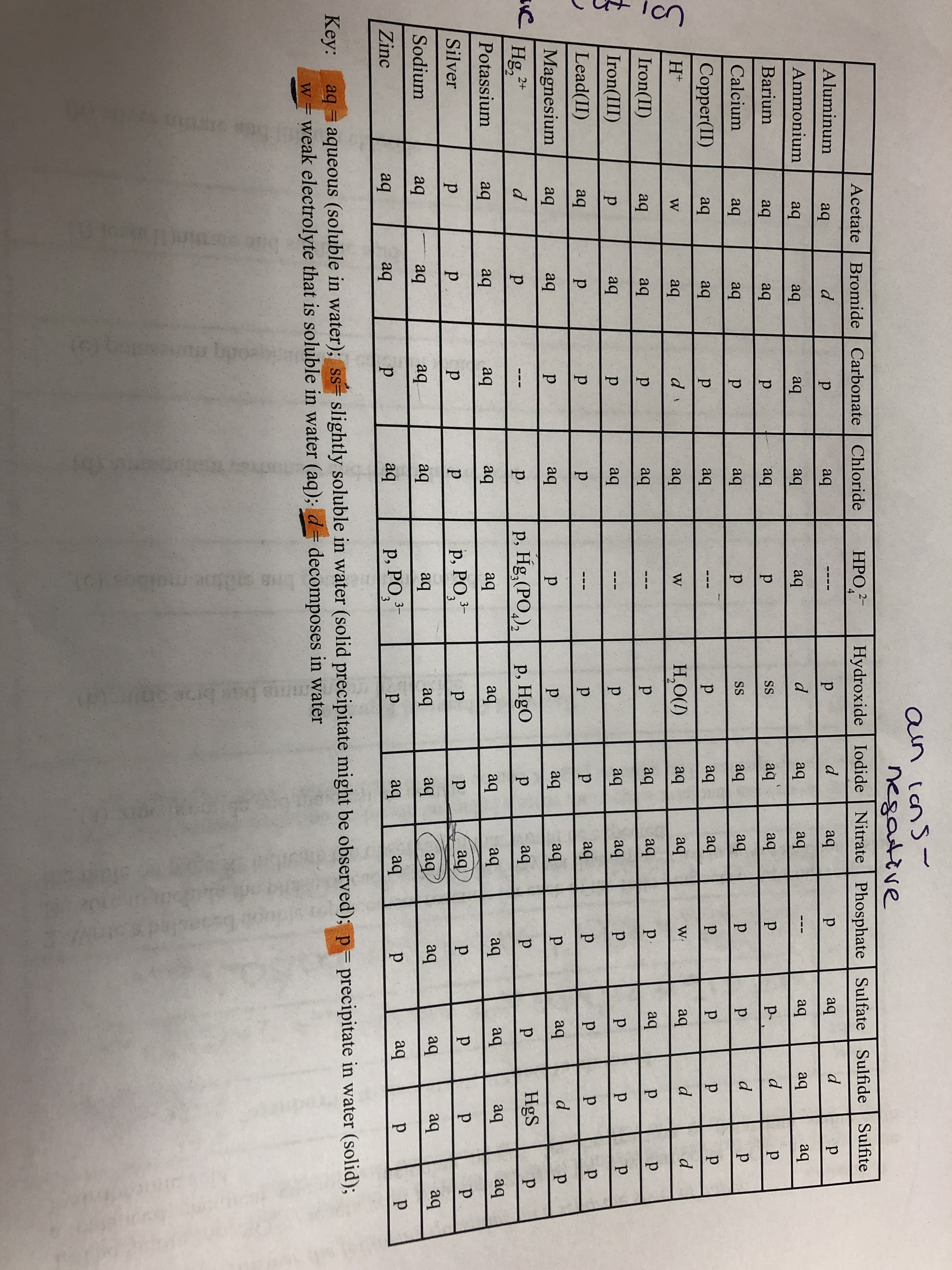2. Write a balanced double replacement reaction for each of the following sets of aqueous reagents. Be sure to include the phase of each species. For any set that is predicted to give a reaction, using the table on page X, indicate the observation that would be expected. (a) zinc bromide and magnesium acetate (b) nitric acid and ammonium hydroxide (c) sodium sulfite and potassium hydroxide (d) ammonium carbonate and hydrochloric acid (e) potassium phosphate and calcium iodide (f) lead(II)nitrate and sulfuric acid Icn di do an icn s- negative Acetate | Bromide | Carbonate Chloride НРО - Hydroxide | Iodide | Nitrate Phosphate Sulfate Sulfide Sulfite Aluminum aq aq aq aq Ammonium aq aq aq aq aq aq aq aq aq aq Barium aq aq aq p. SS aq p- Calcium aq aq aq SS aq aq Copper(II) aq aq aq p. aq aq p. aq aq H,O(1) aq aq aq Iron(II) aq aq aq aq aq p. aq Iron(III) aq aq aq aq Lead(II) aq aq Magnesium aq aq aq aq aq p. aq p. Hg, p, Hg,(PO,), HgS 2+ p, HgO aq p. Potassium aq aq aq aq aq aq aq aq aq aq aq aq Silver p, PO, aq Sodium aq aq aq aq aq aq aq aq aq aq aq aq Zinc p, PO,³- aq aq aq aq aq aq 3 aq = aqueous (soluble in water); ss= slightly soluble in water (solid precipitate might be observed); p= precipitate in water (solid); w=weak electrolyte that is soluble in water (aq); d= decomposes in water Key:
2. Write a balanced double replacement reaction for each of the following sets of aqueous reagents. Be sure to include the phase of each species. For any set that is predicted to give a reaction, using the table on page X, indicate the observation that would be expected. (a) zinc bromide and magnesium acetate (b) nitric acid and ammonium hydroxide (c) sodium sulfite and potassium hydroxide (d) ammonium carbonate and hydrochloric acid (e) potassium phosphate and calcium iodide (f) lead(II)nitrate and sulfuric acid Icn di do an icn s- negative Acetate | Bromide | Carbonate Chloride НРО - Hydroxide | Iodide | Nitrate Phosphate Sulfate Sulfide Sulfite Aluminum aq aq aq aq Ammonium aq aq aq aq aq aq aq aq aq aq Barium aq aq aq p. SS aq p- Calcium aq aq aq SS aq aq Copper(II) aq aq aq p. aq aq p. aq aq H,O(1) aq aq aq Iron(II) aq aq aq aq aq p. aq Iron(III) aq aq aq aq Lead(II) aq aq Magnesium aq aq aq aq aq p. aq p. Hg, p, Hg,(PO,), HgS 2+ p, HgO aq p. Potassium aq aq aq aq aq aq aq aq aq aq aq aq Silver p, PO, aq Sodium aq aq aq aq aq aq aq aq aq aq aq aq Zinc p, PO,³- aq aq aq aq aq aq 3 aq = aqueous (soluble in water); ss= slightly soluble in water (solid precipitate might be observed); p= precipitate in water (solid); w=weak electrolyte that is soluble in water (aq); d= decomposes in water Key:
Chemistry
10th Edition
ISBN:9781305957404
Author:Steven S. Zumdahl, Susan A. Zumdahl, Donald J. DeCoste
Publisher:Steven S. Zumdahl, Susan A. Zumdahl, Donald J. DeCoste
Chapter1: Chemical Foundations
Section: Chapter Questions
Problem 1RQ: Define and explain the differences between the following terms. a. law and theory b. theory and...
Related questions
Question
A-c

Transcribed Image Text:2. Write a balanced double replacement reaction for each of the following sets of aqueous reagents.
Be sure to include the phase of each species. For any set that is predicted to give a reaction, using
the table on page X, indicate the observation that would be expected.
(a) zinc bromide and magnesium acetate
(b) nitric acid and ammonium hydroxide
(c) sodium sulfite and potassium hydroxide
(d) ammonium carbonate and hydrochloric acid
(e) potassium phosphate and calcium iodide
(f) lead(II)nitrate and sulfuric acid

Transcribed Image Text:Icn
di
do
an icn s-
negative
Acetate | Bromide | Carbonate Chloride
НРО -
Hydroxide | Iodide | Nitrate Phosphate Sulfate Sulfide
Sulfite
Aluminum
aq
aq
aq
aq
Ammonium
aq
aq
aq
aq
aq
aq
aq
aq
aq
aq
Barium
aq
aq
aq
p.
SS
aq
p-
Calcium
aq
aq
aq
SS
aq
aq
Copper(II)
aq
aq
aq
p.
aq
aq
p.
aq
aq
H,O(1)
aq
aq
aq
Iron(II)
aq
aq
aq
aq
aq
p.
aq
Iron(III)
aq
aq
aq
aq
Lead(II)
aq
aq
Magnesium
aq
aq
aq
aq
aq
p.
aq
p.
Hg,
p, Hg,(PO,),
HgS
2+
p, HgO
aq
p.
Potassium
aq
aq
aq
aq
aq
aq
aq
aq
aq
aq
aq
aq
Silver
p, PO,
aq
Sodium
aq
aq
aq
aq
aq
aq
aq
aq
aq
aq
aq
aq
Zinc
p, PO,³-
aq
aq
aq
aq
aq
aq
3
aq = aqueous (soluble in water); ss= slightly soluble in water (solid precipitate might be observed); p= precipitate in water (solid);
w=weak electrolyte that is soluble in water (aq); d= decomposes in water
Key:
Expert Solution
This question has been solved!
Explore an expertly crafted, step-by-step solution for a thorough understanding of key concepts.
This is a popular solution!
Trending now
This is a popular solution!
Step by step
Solved in 2 steps with 2 images

Knowledge Booster
Learn more about
Need a deep-dive on the concept behind this application? Look no further. Learn more about this topic, chemistry and related others by exploring similar questions and additional content below.Recommended textbooks for you

Chemistry
Chemistry
ISBN:
9781305957404
Author:
Steven S. Zumdahl, Susan A. Zumdahl, Donald J. DeCoste
Publisher:
Cengage Learning

Chemistry
Chemistry
ISBN:
9781259911156
Author:
Raymond Chang Dr., Jason Overby Professor
Publisher:
McGraw-Hill Education

Principles of Instrumental Analysis
Chemistry
ISBN:
9781305577213
Author:
Douglas A. Skoog, F. James Holler, Stanley R. Crouch
Publisher:
Cengage Learning

Chemistry
Chemistry
ISBN:
9781305957404
Author:
Steven S. Zumdahl, Susan A. Zumdahl, Donald J. DeCoste
Publisher:
Cengage Learning

Chemistry
Chemistry
ISBN:
9781259911156
Author:
Raymond Chang Dr., Jason Overby Professor
Publisher:
McGraw-Hill Education

Principles of Instrumental Analysis
Chemistry
ISBN:
9781305577213
Author:
Douglas A. Skoog, F. James Holler, Stanley R. Crouch
Publisher:
Cengage Learning

Organic Chemistry
Chemistry
ISBN:
9780078021558
Author:
Janice Gorzynski Smith Dr.
Publisher:
McGraw-Hill Education

Chemistry: Principles and Reactions
Chemistry
ISBN:
9781305079373
Author:
William L. Masterton, Cecile N. Hurley
Publisher:
Cengage Learning

Elementary Principles of Chemical Processes, Bind…
Chemistry
ISBN:
9781118431221
Author:
Richard M. Felder, Ronald W. Rousseau, Lisa G. Bullard
Publisher:
WILEY